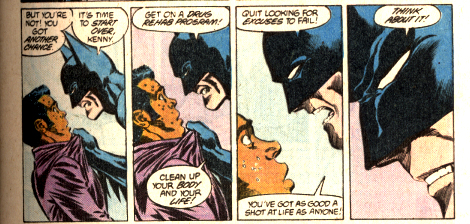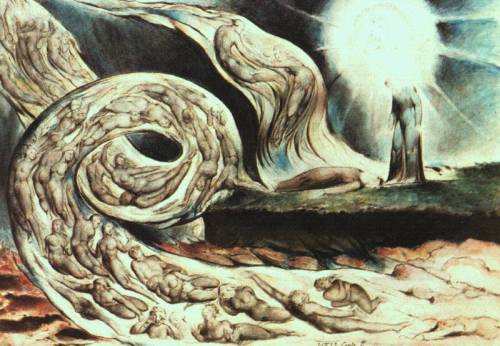
The following article is about My Batman, the Batman interpretation that to me, is the definitive, ‘proper’ Batman. For this, I not only look specifically to the comics, as they are the source — any other novelizations, television series, or film, is merely an adaptation of that source — but it so happens that my definitive Batman can be found in one, single Batman comic, published in September 1988, Batman #423, also known as You Should Have Seen Him …
Although I am picking one specific comic, that comic is actually part of an era of Batman that I am partial to, and so some history is necessary before I get into my review.
The year is 1987. Beside the Indian Grocery store that my mom frequented, was a comic book store called Target Comics, run by, what appeared to be to my 7 year old eyes, a biker gang, although they were likely just stoners who liked rock ‘n’ roll and read a lot of comics in between perfecting Motorhead riffs. And it was amidst this rock ‘n’ roll troupe that I began my first foray into the world of comics, and to their credit, they never kicked me out or scolded me when 90% of the time, I never had enough pocket change to buy anything.
My first comic book that I think I ever bought was the first issue of the relaunch Aquaman title at the time. Although I never had enough pocket change or meager allowance money to buy subsequent issues of that particular series, I did, on one particular day, see a ‘value pack’ of Batman comics. The 3-pack was such a cool deal that I had just enough to get it, and so I did. Contained in that 3-pack were Batman #414, Batman #415, and Batman #416. While Batman #415 was part of the larger ‘Millenium’ storyline that told its story among various titles across the DC universe, Batman #414 and Batman #416 were self-contained stories about Bruce Wayne written by Jim Starlin, a fascinating and by all accounts, grossly underrated comic book writer of the 80s. While Batman #414 dealt with Bruce Wayne’s relationship to a woman whom he is unable as Batman to save from a serial killer due to a bad hunch, and the grief that follows, Batman #416 deals with the schism between the first Robin turned Nightwing, Dick Grayson, and Bruce Wayne/Batman. More broadly, the issue deals with the challenge set by father and son in expressing their need for one another, even if the son must go his own way. Both stories are remarkably nuanced and emotional, with action either being secondary or existing purely to further the emotional journey of the characters.
It was the memory of this ‘forgotten Batman’ of my youth that inspired me to dig through a back issue bin at my last comic book convention and seek out more forgotten Starlin issues, where I came across an issue that captures, in my mind, everything Batman is to me: Batman #423: You Should Have Seen Him ….
Told in the words of three different police officers sitting in a diner after their shift, each with their own ‘Batman encounter’ to tell of, the issue bears conceptual and structural similarity to Batman #250: The Batman Nobody Knows! (1973), written by Frank Robbins, in which a group of kids trade wildly imaginative (and inaccurate) campfire stories of their witnessing of Batman (the concept was later adapted to the animated show The New Adventures of Batman to pay tribute to both the Golden Age Batman and the Batman of The Dark Knight Returns, and then again in the animated film Gotham Knight). However, instead of colorful reimaginings, what we get from the resting officers of the law are accounts of three different men in one, of a hero as complex as any one of us, whom we both admire and relate to.
In the first story, a young, poor, black man named Kenny is about to throw himself off of a bridge, gaining the attention of the police and a crowd of onlookers. He explains that as a junkie, he is incapable of recovering his life from the mess it has become. Arriving on the scene is Batman, whose presence only seems to provoke the man further. After some back and forth, Kenny says, “Listen man, I’m poor, I’m black … I got a jones I can’t shake … got no family, no job … no future … ain’t no better life waiting for me.” The junkie then jumps, and Batman leaps after and catches the man in mid-air while suspending both of them from his Bat-rope.

Batman: “That was real stupid, Kenny. You threw your life away! Wasted it! By all rights, you should be dead now! But you’re not! You got another chance. It’s time to start over Kenny, get on a drug rehab program. Clean up your body and your life. Quit looking for excuses to fail! You’ve got as good a shot at life as anyone …”
While we live in the kind of sad society that thinks of dialogue as this as over the top, or conjuring elements of an ‘after school special,’ I can’t think of many moments in comics as awesome as this. Here’s Batman saying to a very troubled, angry, self-hating young man, with very little to live for, to get his life together. It’s not a deep or complex sentiment, nor is it ‘badass’, but it’s to the point and it is, in a sense, what Batman is saying to all of us who’ve been in Kenny’s situation, if even slightly. Who among us is so foolish and arrogant, and, well, darn crazy enough not to listen to Batman when he lays it down like that? The significance of this entire episode is not only its ability to motivate anyone from shaking the excuses they make for themselves, but that during this time in the 80s, drugs were becoming an ever increasing problem in America, as were racial tensions. Whether or not many of the comic’s target audience were even reading it at the time, it is essentially Batman saying to the nation’s youth, ‘Quit making excuses and get your shit together!’
Here, Batman is speaking in a tone which could be considered self-righteous, but the fact that Batman not only stops the man from committing suicide, but stays behind to lecture him, conveys that he’s not simply a hardened vigilante who goes after murderers and robbers, out for vengeance or to maintain some abstract sense of order, but rather, that he genuinely cares about this person. He wants this man, this junkie, to make something of himself, to rectify his mistakes, and very unlike the sullen, stoic Batman of later comics, he speaks his mind to him in broad daylight. Sure, there’s a time for lurking in the shadows, but sometimes, you just need to come out with it.
As a segway into the second story, the cop who’s just been told this tale replies, “the Batman I saw was a totally different person.”
He tells of a Batman not unlike the dark, violent character of Frank Miller’s The Dark Knight Returns, or Christian Bale’s Batman interrogating Detective Flask in Batman Begins (“SWEAR TO ME!”). A young punk threatens to kill an old lady inside a held up convenience store. Batman swears that if the gang member pulls the trigger, he’d inflict endless pain upon him … endless because Batman would not let him die, no matter how he suffered by his hand. The scene ends with Batman hurling the young man through the window.

This Batman is true to familiar form, but I will not discuss it in great depth here, as it has been the aspect of the character most seized upon and popularized by comics and film. I will say that it’s cool when Batman ‘gets all badass’ like he does here, but it doesn’t reach sublime depths of storytelling or characterization on its own. It is, however, a necessary incident within the larger fabric of the comic, for its plain acknowledgement of violence, juxtaposing one extreme of the character with the contradicting gentility of the third and final story.
As the second cop concludes his story with the line, “That Batman is one tough ol’ mother. Mean and cold as ice,” a third cop, Officer Kirby Jackson, approaches the two and states, “No, he’s not.”
Kirby Jackson tells how he cornered two, very young homeless children in an alley, Batman showed up, and the kids threatened Batman and the police officer with a baseball bat. While the police officer was scared for the kids, knowing Batman only as a dark, violent character of the night, Batman says unexpectedly, “Can we talk about this?” The children, coaxed by his understanding and ease with them, tell their story. Their mother had died in a car crash, and their father had lost his job soon after. In an attempt to make ends meet by cheating in a poker match, he was killed, leaving the orphaned brother and sister in the hands of the foster care system. The two siblings, having been told that they would be placed in different homes, ran away and chose to live on the street, out of a shipping crate underneath an underpass, eating scraps. They couldn’t bear to go on without the only family they had left: each other.
The following moment the cop describes is gut wrenching:
“That’s when I saw it. He turned his face away from the fire, hoping the shadows would hide it, but I saw it anyhow.”

A single tear falls down Batman’s cowled cheek, and Batman promises that Bruce Wayne will find a home in which the children can live together.
This is the moment that makes the comic for me, because it’s not only unusual for the character in terms of what is most often written, it addresses what kind of a man Batman is. In the first story, he is direct and firm, the voice of sanity and divine purpose to a soul that’s lost its way. In the second, we see the anger and the hatred contained within him at a person who would hurt another for personal gain He is the vengeful angel we’ve always known … but in this final story, Batman is simply a man of unbridled compassion and sympathy. He’s a human being.
I remember after reading those first Starlin Batman comics, #414 and #416, I was introduced to such graphic novels as Arkham Asylum, Batman: Year One, and The Dark Knight Returns, by my uncle. The darkness and violence and psychology of those elaborate and by now famous titles captivated me as I moved into adolescence, but years later, as an adult male, they barely scratch the surface of what Batman really means to me. While they delivered the necessary ‘push’ for Batman to remerge into the mainstream as a dark and brooding figure of the night, they also began a trend that, by the time the late ‘90s came around, had turned Batman into a shallow, callous jerk. Another unfortunate result is that from the standpoint of the non-comic reading mainstream, Batman was most defined by the 1960s show, a respectable and historic pop culture product, but still campy, superficial, and comedic. Just about everyone who doesn’t know the legacy of the character well enough, but ‘just kinda’ knows it, thinks that it was Frank Miller who was most responsible for the rehauled and grown up Batman, responsible for Batman being a serious, mature character from the pulps, as opposed to the Adam West incarnation of the 1960s. The truth is, the ‘darker than dark’ Batman of Frank Miller, later co-opted by Tim Burton and popularized through subsequent writers, is to the campy 1960s Batman what a 14-year old’s perception of the world is to an 8-year old’s perception of the world. It’s grown, but not ‘grown-up’.
Actually, as my review of Batman #423, proves, Batman had been grown-up and smart for some time , thanks to writers like Jim Starlin who were carrying on the tradition of Dennis O’Neil, the real deal when it came to the intelligent design of Batman’s evolution (it is debatable what influence Frank Miller had on Starlin, as some of Frank Miller’s work came slightly before or during it, although it is inarguable that #423’s Batman is a much different hero than Frank Miller’s in terms of TDKR or Year One.). Batman was not campy in those early 70s-80s comics and he wasn’t a super-dark sociopath either. Batman, for all his tragedy, was a smart, committed, responsible man who cared for the well being of others, and who used every means at his disposal to help those people he could still save. His life experience had predisposed him to a hatred of criminals, commitment to his objectives, and a slightly rigid, if ontological sense of right and wrong. As abnormal a man as he may be, Batman’s sanity, rarely, if ever, escapes him. Most importantly, Batman had sympathy for the weak, and it was out of this sympathy that he sought to protect and help them.
Based on that acceptence of the character, Batman #423 is my definitive Batman comic … not Year One, not TDKR, or anything which has come after. The reason being that through contradiction and extremes, we find the man caught within, and it not only makes us understand him, but care about him. In the 22 pages of this monthly issue published over 20 years ago, more is covered and established about the character than in most trades or graphic novels, or for that matter, Batman films.
Anyways, that’s ‘My Batman.’ What’s yours?















